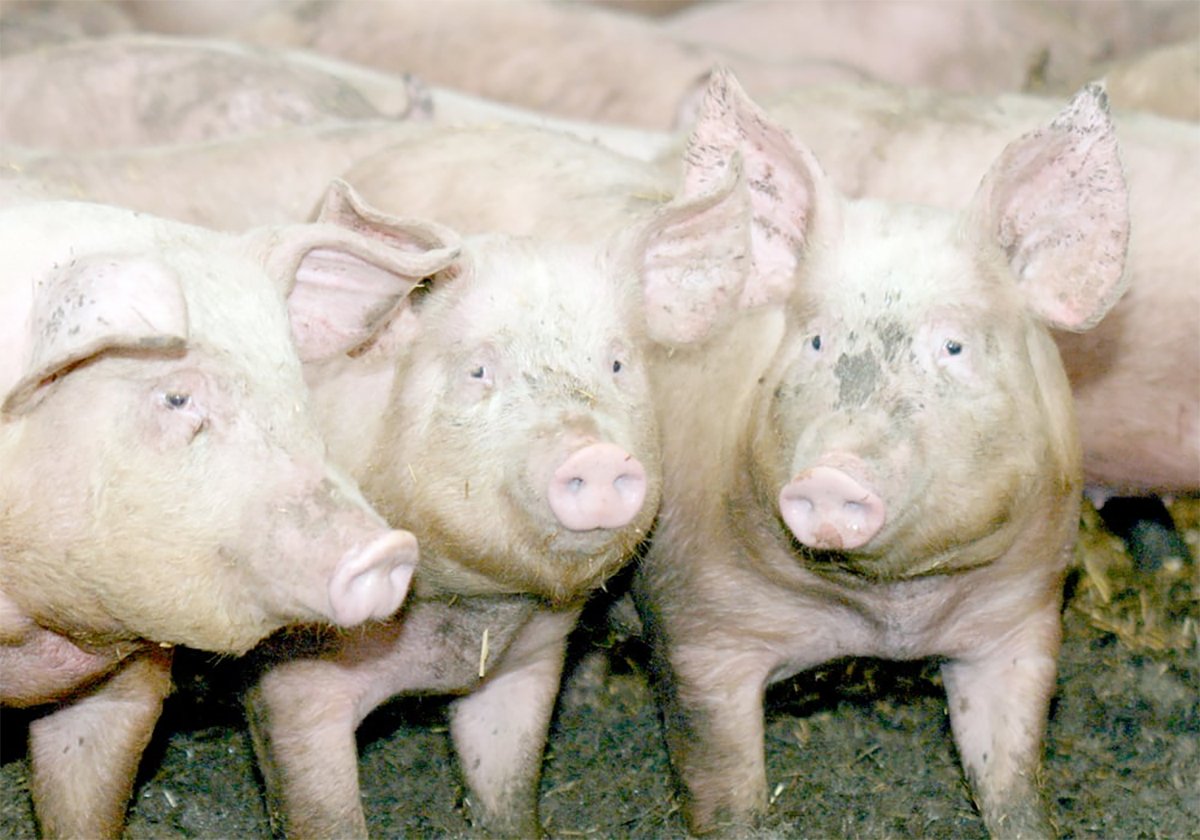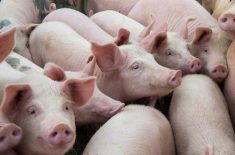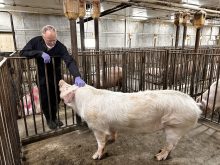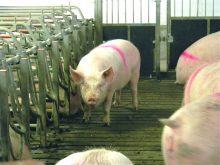Evolution of the enemy
LINDELL BEACH, B.C. — Researchers have discovered a genetic marker that identifies pigs with reduced susceptibility to porcine reproductive and respiratory syndrome (PRRS).
The breakthrough promises to be a game changer for pig breeders.
It was a collaborative effort involving Kansas State University, the U.S. Department of Agriculture, the National Pork Board, Genome Canada and other academic facilities, and was published in the Journal of Animal Science.
“This discovery is what you call a first-first,” said Raymond “Bob” Rowland, a virologist and professor of diagnostic medicine and pathobiology at KSU.
Read Also

The Western Producer Livestock Report – November 13, 2025
Western Producer Livestock Report for November 13, 2025. See U.S. & Canadian hog prices, Canadian bison & lamb market data and sales insights.
“This discovery is the first of its kind for PRRS but also for any large food animal infectious disease. I have worked in the field for 20 years and this is one of the biggest advances I have seen.”
Rowland and researchers Jack Dekkers from Iowa State University and Joan Lunney with the USDA’s Animal Parasitic Diseases Laboratory in Beltsville, Maryland, discovered a genetic marker called a quantitative trait locus (QTL), which is associated with porcine reproductive and respiratory syndrome virus susceptibility. It’s the first step to controlling and eliminating the virus.
“With PRRS, there isn’t a magic bullet,” said Rowland.
“If we can show that pigs can still retain weight gain and performance and if we can reduce the virus from spreading, then those two factors will make a significant contribution.
“(The research) was initiated by Joan Lenney,” said Rowland, who is co-director of the PRRS Host Genetics Consortium (PHGC) and director of the U.S.-funded PRRS Co-ordinated Agriculture Project.
“She was the spearhead in 2006 to look at pig genetics. I joined in 2007 and we put together PHGC. We needed to do big science and there was no single source of funding to accomplish this. So in forming this consortium, we collected money from (a variety of sources). We took this huge pool of money and finally we could do some decent genetics. Genome Canada and Genome Alberta are our latest partners. We started working with them about a year ago. The PHGC takes fundamental science and turns it into utility.”
Most of the project’s experimental work was done at KSU’s Large Animal Research Center, where the researchers obtained multiple measurements of pigs, including growth, weight gain, performance and virus measurements.
They started in 2007 with 600 pigs and now, working with Genome Canada, have collected samples from 2,300 pigs for a total of more than 100,000 samples.
The university sent samples to the USDA for genomic DNA preparations to identify differences in more than 60,000 genes. The data was then transferred to ISU for genetic analysis that led to the discovery of the QTL.
The researchers at ISU created a common database so that researchers and breeders could access all material at multiple locations over the long term.
“My job is in virology,” Rowland said.
“We can combine state of the art genetics and virology. This is what is so unique about this approach. When you do a genetic study, you look at the pigs, take their DNA and find those markers on the DNA that correlate with disease. But you don’t know why. The pig is sick or it could have an allergy. The first time we took the virus and put it into pigs, we took multiple measurements over time and we got some very good quantitative data on disease traits.”
Rowland said the markers they found were favourable for developing breeding programs. By understanding the genetics more fully, producers could apply that knowledge to breeding animals with less susceptibility to PRRS.
The research showed that only a small percentage of the pig population has the favourable disease trait with reduced susceptibility so, through careful selective breeding, it will be possible to increase that segment of the pig population.
Pigs infected with PRRS are expensive for farmers, not only in care but also in feed costs. They eat but don’t thrive or gain weight.
Rowland calculated that production systems that have PRRS suffer losses of 10 percent.
“I see this not so much a ray at the end of the tunnel as a positive step forward,” he said.
“You take the best vaccine and line it with the best genetics, best diagnostic test and best management practices. Then we will see headway.”
It’s still uncertain whether the discovery of this QTL opens up opportunities to address the susceptibility of other livestock species to diseases. If it offers resistance to PRRS, how does it function in relation to influenza or the PCAD virus?
“This QTL marks pigs that give a very strong vaccine response,” he said.
“But every pig responds differently to a vaccine. (With this discovery), we can ask very specific, answerable questions about this QTL.”
He said Genome Canada has been a significant partner in the effort to reduce incidence of PRRS.
“The more we can cooperate together, the better this will get.”
The next step is to find more genes, take the research into the field on farms and look for more genetic profiles.
“The unique aspect of this project is that we have been looking at genes that may provide long-term resistance to a lot of infections,” said Rowland.
“This is very important for animal health because there are a lot of diseases for which there are no cures and no vaccines. Now we have a tool to study these diseases.”
Facts about porcine reproductive and respiratory syndrome
- According to The Pig Site, PRRS was first isolated and classified in 1991. It was once called the mystery swine disease and has also been known as blue ear disease.
- Clinical signs of infection include loss of appetite, elevated temperature, late-term abortions, still births, weak piglets, discolouration (blueing of the ears), coughing and other respiratory signs, early farrowing and prolonged anoestrus.
- PRRS virus infected two million pigs in China in 2006-07, killing 20 percent of their stock.
- The PRRS virus costs the U.S. pork industry more than $600 million a year, while Genome Alberta says the combination of PRRS and porcine circovirus associated disease costs the Canadian pork industry $100 million in annual losses. They are the two most important infectious disease problems in swine.
- Raymond Rowland of Kansas State University said PRRS has always existed, but pig production and management have changed.
- Starting in the 1970s and 1980s, modern intensive pig production in barns created the right environment for the virus to not only thrive but adapt to the modern pig farming methods of high concentration in a confined environment. With the use of artificial insemination, the virus can efficiently transfer from sow to offspring.
Source: www.thepigsite.com, Kansas State University | WP GRAPHIC















